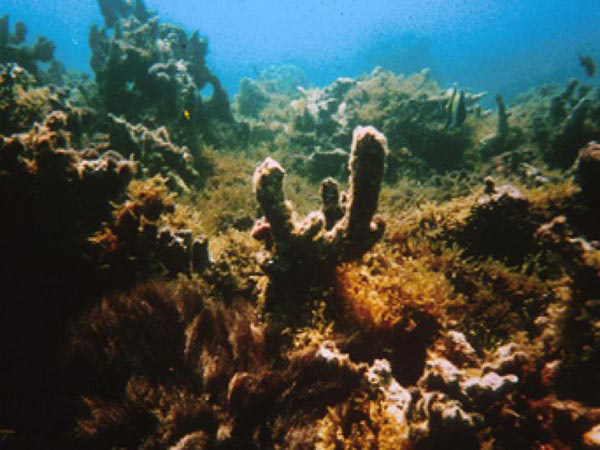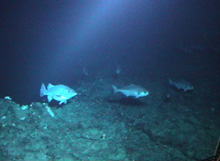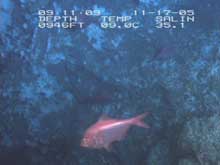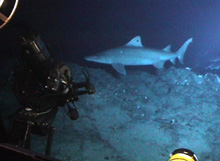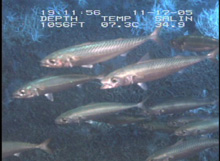Figure 1. A single wreckfish on the left and a school of barrelfish swim onto the crest of Miami Terrace. Click image for larger view and image credit.
Figure 2. There are four alfonsino fish in this picture. The color red disappears quickly in the water column and so red-colored animals are virtually invisible in deep water. Members of this genus (Beryx) typically migrate from the seafloor into the water column to feed on mid-water animals. Click image for larger view and image credit.
Deep Predators of the Miami Terrace
November 18, 2005
Doug Weaver, M. Sc.
Research/GIS Specialist
Flower Garden Banks National Marine Sanctuary
![]() View
video footage of a large school of mackerel which appeared to follow the submersible. (Quicktime, 1 Mb.)
View
video footage of a large school of mackerel which appeared to follow the submersible. (Quicktime, 1 Mb.)
![]() View
video footage of a compiliation of deep-sea predators from the Flordia Deep Corals Exploration. (Quicktime, 1.6 Mb.)
View
video footage of a compiliation of deep-sea predators from the Flordia Deep Corals Exploration. (Quicktime, 1.6 Mb.)
Today brought the opportunity of a lifetime. After rising at 2 a.m. to help coordinate mapping efforts of the morning dive site, I was chosen as the lead observer for the Johnson-Sea-Link (JSL) dive #4919,which meant I would be riding in the front acrylic sphere. I have been lucky enough to take three previous ventures in the rear chamber of this submersible, where the view is limited to two small acrylic ports illuminated by small "snooperette" spotlights and sodium vapor lights. The view from the front compartment, however, is spectacular, as the sphere functions as a large fisheye lens, with a near panoramic view, and the large arc light of the sub fully illuminates the surrounding seafloor and water column.
As is typical for a JSL dive, the preparation was smooth, and the pre-dive briefing finished at 8 am. By about 8:10 we were loaded into the sub and hoisted from the mother ship into the clear blue water of the Gulf Stream.
Our dive site was a location where some wreckfish, barrelfish, and bright red alphonsinos (Figures 1, 2) had previously been observed.
As we reached the crest of the dive site, large blocks of phosphorite, the smooth, black rock that dominates the surface of Miami terrace, became abundant and provided suitable potential fish habitat. Almost immediately, a few wreckfish were visible in the distance, swimming along the crest and upper wall of the feature. As we conducted survey transects to document the benthic (organisms which live attached to the bottom) community of Lophelia corals and Stylaster hydrocorals, we also conducted fish counts. We were then visited by two sand tiger sharks (Figure 3), which swam directly towards the sub and passed right in front of the acrylic sphere.
My first dive as lead observer couldn’t have been any better. We successfully completed three transects (surveys along a pre-determined path) along the dive site, and collected numerous samples of Lophelia and Stylaster for studies being conducted by scientists participating in the cruise. The diversity of fishes was high, and the bottom was covered with dense colonies of Lophelia, Stylaster, numerous gorgonians and bamboo corals.
Sign up for the Ocean Explorer E-mail Update List.
























